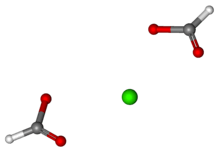Calcium formate
 | |
 | |
| Names | |
|---|---|
| Systematic IUPAC name
Calcium methanoate | |
| Other names
formic acid calcium salt, calcoform | |
| Identifiers | |
3D model (JSmol) |
|
| ChemSpider | |
| ECHA InfoCard | 100.008.058 |
| EC Number | 208-863-7 |
| E number | E238 (preservatives) |
| KEGG | |
PubChem CID |
|
| RTECS number | LQ5600000 |
| |
| |
| Properties | |
| Ca(HCO2)2 | |
| Molar mass | 130.113 g/mol |
| Appearance | white powder |
| Odor | weak, caramel-like odor |
| Density | 2.009 g/cm3 |
| Melting point | decomposes at 300 °C |
| 16.1 g/100 ml (0 °C) 16.6 g/100 ml (20 °C) 18.4 g/100 ml (100 °C) | |
| Solubility | insoluble in alcohol |
| Hazards | |
EU classification (DSD) (outdated) |
not listed |
| NFPA 704 | |
| Related compounds | |
Other anions |
Calcium acetate |
Other cations |
Sodium formate |
Except where otherwise noted, data are given for materials in their standard state (at 25 °C [77 °F], 100 kPa). | |
| Infobox references | |
Calcium formate, Ca(HCO2)2 (or. Ca(HCOO)2), is the calcium salt of formic acid, HCOOH. It is also known as food additive E238 in food industry. The mineral form is very rare and called formicaite. It is known from a few boron deposits. It may be produced synthetically by reacting calcium oxide or calcium hydroxide with formic acid.
References
This article is issued from
Wikipedia.
The text is licensed under Creative Commons - Attribution - Sharealike.
Additional terms may apply for the media files.
